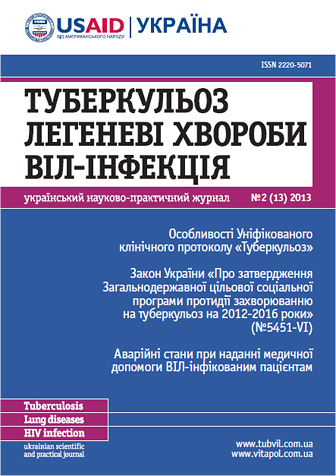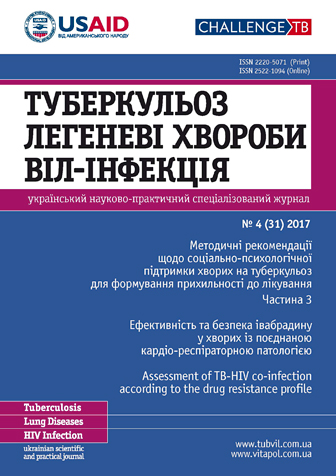- Issues
- About the Journal
- News
- Cooperation
- Contact Info
Issue. Articles
¹2(13) // 2013

1. Editorial
|
Notice: Undefined index: pict in /home/vitapol/tubvil.vitapol.com.ua/en/svizhij_nomer.php on line 74
|
|---|
Unified clinical protocol «Tuberculosis» was approved in December 2012. The document was developed by multi-disciplinary working group in accordance with international standards and its basic principle of using global best practices of evidence-based medicine. The basis of Protocol is Ukrainian adapted clinical guidelines based on evidence «Tuberculosis». This is the first clinical protocol on TB, which clearly defines scope of activities for identification, diagnosis, treatment, and prevention of TB in primary, secondary, and tertiary healthcare facilities. Other feature of the new protocol is epidemiological approach for case management using identification of the most dangerous smear positive cases and MDR TB cases, their immediate isolation and correct treatment from the first day. This ideology is based on the introduction of rapid diagnostical methods for tuberculosis and multidrug-resistant tuberculosis (liquid cultures and molecular genetic methods, including rapid method using Xpert MTB/RIF).
Keywords: ñlinical protocols, tuberculosis, multidrug resistant tuberculosis.
![]() To download
To download
full version need login
Notice: Undefined variable: lang_long in /home/vitapol/tubvil.vitapol.com.ua/en/svizhij_nomer.php on line 143
2. Original research
|
Notice: Undefined index: pict in /home/vitapol/tubvil.vitapol.com.ua/en/svizhij_nomer.php on line 74
|
|---|
Objective: to examine the incidence and pattern of drug resistance in patients with MDR TB and XDR TB depending on the case of disease, the profile and duration of previous treatment in order to determine the value of the first and second-line TB drugs in standard and individualized regimens.
Materials and methods. The study included 400 patients with MDR TB and 127 patients with XDR TB who underwent treatement in Yanovsky National Tuberculosis and Lung Diseases Research Institute, Medical Academy of Sciences of Ukraine for the period from 2007 to 2012. Drug susceptibility test to the first-line anti-TB drugs was performed on the liquid culture medium with the use of microbiological automatic analyzer, to the second-line anti-TB drugs — on the liquid and solid medium.
Results and discussion. The study results revealed high level of resistance in any combination in MDR TB patients to the next drugs: streptomycin (S) in 88.7 % of cases, ethionamide (Et) in 51.2 %, ethambutol (E) in 42.5 %, pyrazinamide (Z) in 35.7 %, kanamycin (Km) in 28.7 % (p < 0,05, except for the difference between E and Z resistance). Drug resistance to fluoroquinolones (Ofx), capreomycin (Cm), PAS was detected rarely. The most common resistance among patients with XDR TB was to S — in 99.2 % of patients, Km — 90.6 %, E — in 74.0%, and Et — in 72.4 % of patients. Resistance to Cm, Z, PAS occurs in significantly fewer cases — in 48.0 %, 35.4 %, 25.2 %, respectively. XDR TB patients showed significantly higher incidence of resistance to S, E, Et/Pt, Km/Am, Cm, Ofx, PAS in comparison with MDR TB patients. Z drug resistance was of the same frequency in both MDR and XDR cases (35.7 % and 35.4 % respectively). The incidence and pattern of drug resistance does not significantly depend on the case, profile (the use of second-line anti-TB drugs) and duration of previous treatment.
Conclusions. Streptomycin is losing its role in the treatment of patients with MDR TB and XDR TB regardless of case due to the high level of drug resistance. Ethambutol should not be used in standard chemotherapy regimens for the fourth category due to the high levels of resistance to the drug regardless of the case. While prescribing the standard 4th category regimen including kanamycin one should simultaneously determine drug susceptibility to the first and the second-line drugs using fast liquid medium methods, since 28.7 % of MDR TB cases are diagnosed resistant to this drug. The high level of resistance to ethionamide/protionamide regardless of case in MDR TB and XDR TB patients (51.2—72.4 %) casts doubt on the effectiveness of this drug in individualized regimen and requires further controlled studies on the effectiveness of these drugs.
Keywords: multidrug-resistant tuberculosis and tuberculosis with extensive drug resistance, drug sucseptibility profile.
![]() To download
To download
full version need login
Notice: Undefined variable: lang_long in /home/vitapol/tubvil.vitapol.com.ua/en/svizhij_nomer.php on line 143
3. Original research
|
Notice: Undefined index: pict in /home/vitapol/tubvil.vitapol.com.ua/en/svizhij_nomer.php on line 74
|
|---|
Îbjective: to study applicability of discriminative analysis for diagnostics of the most widespread respiratory diseases.
Materials and methods. 26 examination indicators data for 230 patients, methods of the discriminative analysis, methods of regularized approximation.
Results and discussion. Recieved data of primary medical examination modified by nonlinear transformation of coordinates and supplemented with approximating values of indicators of mineral density of bones showed satisfactory results of diagnosing of the four most widespread respiratory diseases (cancer, tuberculosis, sarcoidosis, pneumonia) with application of the discriminate analysis.
Conclusions. Òhe method and its software are practicaly applicable in primary healthcare facilities.
Keywords: differential diagnosis, respiratory diseases, discriminative analysis, regularization.
![]() To download
To download
full version need login
Notice: Undefined variable: lang_long in /home/vitapol/tubvil.vitapol.com.ua/en/svizhij_nomer.php on line 143
4. Original research
|
Notice: Undefined index: pict in /home/vitapol/tubvil.vitapol.com.ua/en/svizhij_nomer.php on line 74
|
|---|
Objective: to carry out the analysis of dynamics of of liver pathology biochemical markers and development of hepatotoxic reactions in pulmonary tuberculosis patients with concomitant liver pathology in the course of the antituberculosis drug administration using regional lymphotropic therapy with the further ultrasound therapy in patients with the newly diagnosed destructive pulmonary tuberculosis.
Materials and methods. All patients with the newly diagnosed destructive pulmonary tuberculosis (152 persons) were divided into 3 groups: the 1st and the 2nd main groups and the control group. All groups recieved complex antituberculosis treatment with standard drug combinations and dosage. Regional lymphotropic therapy with further ultrasound therapy of axillary area was used in the 1st main group, while the the 2nd main group was carried out only regional lymphotropic therapy.
Results and discussion. The use of regional lymphotropic methodology of isoniazid administration lead to the sighnificant decline of hepatotoxic drug-induced damages and more favourable course of concomitant liver pathology. Application of regional lymphotropic therapy with further ultrasound therapy and regional lymphotropic therapy alone in the complex treatment resulted in less frequent hepatotoxic reactions in comparison with standard antituberculosis therapy (6.8 %, 6.8 % ànd 10.0 % respectively). Recieved laboratory data were associated with clinical findings.
Conclusions. Regional lymphotropic therapy minimizes drug system effects and reduces drug intravascular interaction, as a result providing reduction of the number of toxic adverse reactions in patients with destructive pulmonary tuberculosis, especially with concomitant liver pathology.
Keywords: biochemical markers, liver pathology, hepatotoxic reactions, lymphotropic therapy, ultrasound therapy.
![]() To download
To download
full version need login
Notice: Undefined variable: lang_long in /home/vitapol/tubvil.vitapol.com.ua/en/svizhij_nomer.php on line 143
5. Original research
|
Notice: Undefined index: pict in /home/vitapol/tubvil.vitapol.com.ua/en/svizhij_nomer.php on line 74
|
|---|
Objective: to study the results of the programmes for diagnosis and treatment of STIs among representatives of risk groups of HIV infection by introducing models of diagnosis and treatment of STIs according to the official reporting data.
Materials and methods. The results of the projects of the diagnosis and treatment of STIs were studied in 5 models of organization of such services by analyzing the official reporting indicators presented by providers and partner NGOs for the period of 2008—2012 years.
Results and discussion. Against a background of growth of institutions involved in diagnosis and treatment of STIs in risk groups, there has been some reduction in the number of partner NGOs. At the same time, there has been growth and volume of services provided by the STIs diagnostics representatives. Analysis results show that the growth in the number of STIs diagnostic services is not directly associated with the growing number of service providers and their partner organizations.
Conclusions. Increase in project coverage of representatives of target groups is due to the activity improvement in organizations providing these services after implementation of organizational models. Specific studies are required for the in-depth analysis of the programs’ performance.
Keywords: model of diagnosis and treatment, risk groups, STIs, HIV/AIDS.
![]() To download
To download
full version need login
Notice: Undefined variable: lang_long in /home/vitapol/tubvil.vitapol.com.ua/en/svizhij_nomer.php on line 143
6. Original research
|
Notice: Undefined index: pict in /home/vitapol/tubvil.vitapol.com.ua/en/svizhij_nomer.php on line 74
|
|---|
Objective: to assess the existing system for recording and management of the health care workers (HCWs) — victims of exposure with blood or other body fluids (BBF) of HIV-infected patients in the health care settings of the Sumy region.
Materials and methods. Reporting, management and analysis of injuries with needles and sharp instruments (NSI) were held in the regional center for prevention and control of AIDS (CCPA) using EPINet, which in collaboration with the company Becton-Dickinson (BD) has developed and kindly provided Dr. Janin Jager, Virginia Univ.
Results and discussion. The analysis of incidents that occurred in the medical care settings with HCWs showed that the most dangerous ones are occurring with skin damage. Very low level of such incidents in the area is a result of underreporting. As might be expected, most NSIs occur with the nurses. Qualifications and professional experience of the HCWs do not affect the level of incidence. Seroconversion among the HCWs as a result of occupational transmission was not observed.
Conclusions. Complete reporting of NSIs is a prerequisite for the identification of risky procedures and to ensure optimal management and treatment of the affected health care personnel. The accident insurance doctor must possess a high degree of interdisciplinary competence in order to treat NSI effectively. A list of measures, the implementation of which will reduce the risk of occupational transmission of HIV from patients to workers is proposed.
Keywords: HIV infection, haemocontact infections, accidents, accident and its consequenses prevention.
![]() To download
To download
full version need login
Notice: Undefined variable: lang_long in /home/vitapol/tubvil.vitapol.com.ua/en/svizhij_nomer.php on line 143
7. Original research
|
Notice: Undefined index: pict in /home/vitapol/tubvil.vitapol.com.ua/en/svizhij_nomer.php on line 74
|
|---|
Objective: to study the ventilative-perfusion lung function in patients with LC and interpret pathogenesis of its disorders.
Materials and methods. The study involved 63 patients with LC (43 male and 20 female) without concomitant disorders of the respiratory system of other origins. All the patients along with the general clinical, laboratory and instrumental examinations underwent the examination of the respiratory system by the method of research of venous blood gas composition on the instrument «Analyzer of acid-base balance of blood EC-60». In order to study the mechanisms of its functional and organic disorders we defined levels of cyclic guanosine monophosphate (cGMP, sGMP) using test set «Assay Designs Correlate — EIA cyclic GMP» (made in USA), TNF-a (TNF-a) — test set ELISA ( production of France) and endothelin-1 (E-1) — ELISA test kits (made in USA). Statistical analysis was conducted using the Excel program in accordance with principles of descriptive statistics.
Patients’ written informed consent for conducting of complex of clinical-laborato¬ry and instrumental examination was received in accordance with the principles of the Helsinki Declaration of Human Rights, Council of Europe Convention about Human Rights and Biomedicine and applicable laws of Ukraine.
Results and discussion. All 63 patients with LC (43 male (68.3 %) and 20 female (31.7 %) aged from 18 to 79 years) presented the disorders of ventilative-perfusion lung function (100.0 % of cases). Changes in blood gas composition appears in increasing of hypoxemia with impaired ability of haemoglobin to bind and carry oxygen (reduced levels of indices — pCO2, pO2, SAT, O2ST). The results of the study of perfusion parameters, pulmonary vascular endothelial function and organism buffer systems in all patients revealed and confirmed the role of such pathogenic mechanisms of blood oxygenation disorders: the opening of pulmonary arteriovenous shunts, the occurrence of dysfunction of endothelial vasoactive substances and disorders of acid-base balance intensifying with further decompensation of the disease.
Conclusions. Syntropical HPS with the presence of severe increasing hypoxemia caused by endothelial dysfunction occurs in patients with LC, opening of pulmonary arteriovenous shunts and acid-base imbalance of blood status, the severity of which correlates with the severity of the pathological process in the liver. Therefore, all patients with LC should undergo complex clinical-laboratory and instrumental examination with necessary evaluation of ventilative-perfusion parameters for early detection of HPS. The complex treatment must include pathogenetic rationale drugs aimed at inhibiting the synthesis of NO and correction of metabolic acidosis.
Keywords: liver cirrhosis, hepatopulmonary syndrome, hypoxemia, endothelial dysfunction, acid-base equilibrium.
![]() To download
To download
full version need login
Notice: Undefined variable: lang_long in /home/vitapol/tubvil.vitapol.com.ua/en/svizhij_nomer.php on line 143
8. Original research
|
Notice: Undefined index: pict in /home/vitapol/tubvil.vitapol.com.ua/en/svizhij_nomer.php on line 74
|
|---|
Objective: to establish the features of clinical course of the newly diagnosed tuberculosis in HIV-infected individuals depending on the degree of immunodeficiency.
Materials and methods. This open prospective controlled study involved 112 patients with newly diagnosed pulmonary tuberculosis. Group 1 included 35 people with moderate immunodeficiency with the CD4 lymphocytes count > 350 cells/ml. Group 2 included 44 patients with the CD4 lymphocytes count < 350 cells/ml > 100 cells/ml, and in Group 3 — 33 patients with the CD4 lymphocytes count < 100 cells/ml.
Results and discussion. The study revealed significant increase of the incidence of the combination of pulmonary and extrapulmonary tuberculosis with involvement in the process of the pleura (pleural effusion), intrathoracic and peripheral lymph nodes in 38.6 % cases in HIV-infected patients with a CD4+ lymphocytes count decrease lower than 350 cells / ml. Positive smear and culture results were detected in 70.5 % cases, most of them without radiological evidence of lung tissue destruction (68.2 %). The tuberculosis course becomes generalized with disseminated forms of the disease and involvement of other organs in the third group with severe immunodeficiency. Patients with new cases of TB/HIV co-infection frequently (in 41.7 % of cases) posess primary first-line drug resistance. Drug resistance in most cases is determined by poly- and monoresistance, rather multidrug resistance (in 8.3 % cases). Isoniazid resistance was revealed in 31.9 % of patients with new tuberculosis cases. Rifampicin resistance was found in significantly fewer cases — in 13.9 %, including half of the cases without multidrug resistance.
Conclusions. The newly diagnosed tuberculosis in HIV-infected individuals takes atypical manifestations while reducing CD4+ cell count lower than 350 cells/ml: a combination of pulmonary and extrapulmonary disease, low incidence of destructive changes in the lungs. Revealed high frequency of positive smear and culture and MTB drug resistance emphasizes the need of sputum smear microscopy as well as sputum culture with a rapid drug susceptibility evaluation. Half of the rifampicin resistance cases is not multidrug resistant, thus requiring balanced tactics on the management of patients with rifampicin resistance identified by molecular screening method Xpert MBT/Rif.
Keywords: TB / HIV co-infection, tuberculosis peculiarities, MTB drug resistance incidence.
![]() To download
To download
full version need login
Notice: Undefined variable: lang_long in /home/vitapol/tubvil.vitapol.com.ua/en/svizhij_nomer.php on line 143
9. EPIDEMIC SITUATION
|
Notice: Undefined index: pict in /home/vitapol/tubvil.vitapol.com.ua/en/svizhij_nomer.php on line 74
|
|---|
Comprehensive assessment of the main indicators of TB prevalence in Odessa Region does not support the evidence of HIV/TB epidemic stabilization, while a significant increase in HIV/AIDS incidence, together with high HIV seroprevalence rate among pregnant women and predominantly sexual route of HIV transmission, as well as the increase in mortality due to HIV-related diseases, suggests the generalization of HIV epidemic. Against this background, HIV/TB incidence and HIV/TB-related mortality and lethality among TB patients has substantially grown, as well as the proportion of TB patients among those who died. Thirty-six children co-infected with TB/HIV were observed in the study. Their clinical and radiographic features and disease outcomes did not substantially differ from those in HIV-negative patients with TB of respiratory system, while provision of ART to children with co-infection accelerated the regression of TB manifestations. Severe disease progression with lethal outcome was observed among two children with advanced form of HIV-associated TB of CNS. In general for the past 10-year period four cases of deaths due to TB complicated HIV infection were registered and were diagnosed only based on autopsy results. The strategies to alleviate this situation might include strengthening of targeted communication campaigns among youth, education focused on family values and the culture of responsible sexual relations, pregnancy planning, and improving information exchange between general health care and antenatal care facilities. Importantly, the complex nature of the dual TB/HIV epidemic requires widescale governmental funding of program activities.
Keywords: tuberculosis, HIV infection/AIDS, co-infection, children.
![]() To download
To download
full version need login
Notice: Undefined variable: lang_long in /home/vitapol/tubvil.vitapol.com.ua/en/svizhij_nomer.php on line 143
10. Clinical case
|
Notice: Undefined index: pict in /home/vitapol/tubvil.vitapol.com.ua/en/svizhij_nomer.php on line 74
|
|---|
Levofloxacin is a prior drug among fluoroquinolones in the treatment of multidrug resistant tuberculosis. Literature data confirm its high efficiency, safety and availability. Adverse reactions to Levofloxacin occur in 3.3 %, haematological disorders — in 0.1 %. The article describes the case of thrombocytopathy to levofloxacin in the patient with multidrug resistant tuberculosis. This state was managed with drug withdrawal and the prescription of prednisolone.
Keywords: multidrug-resistant tuberculosis, levofloxacin, adverse reaction, thrombocytopathy.
![]() To download
To download
full version need login
Notice: Undefined variable: lang_long in /home/vitapol/tubvil.vitapol.com.ua/en/svizhij_nomer.php on line 143
Current Issue Highlights
¹4(31) // 2017

Assessment of TB-HIV co-infection according to the drug resistance profile
E.V. Lesnic1, L.D. Todoriko2
Log In
Notice: Undefined variable: err in /home/vitapol/tubvil.vitapol.com.ua/blocks/news.php on line 51

